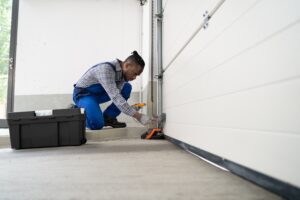What to Do When Your Garage Door Won’t Close Properly

*Updated May 30th, 2025
Opening your garage door to drive your car inside, only to have it stop halfway and refuse to close, is frustrating, to say the least. A garage door that won’t close all the way can happen for several reasons—some just require simple DIY troubleshooting, while others need professional garage door repair.
Knowing the common causes and how to fix a garage door can help you get it working again quickly and safely. Keep reading to understand the top reasons why a garage door won’t close, signs to watch out for, and what to do based on the underlying issue.
4 Common Reasons Your Garage Door Won’t Close
There are a few usual suspects when diagnosing why a garage door won’t close properly. Here are the most common culprits:
1. Misaligned Safety Sensors
Most automatic garage doors have safety sensors, also called photo eyes, on either side of the door near the floor. These sensors prevent the door from closing if something is in the way. When the beams get misaligned, the opener stops the door from closing to avoid damaging anything in its path.
It’s common for the sensors to get bumped out of position over time. Realigning them can often resolve a sensor issue and allow the door to close all the way.
2. Broken Garage Door Spring
Garage door springs support the weight of your garage door and help it open and close smoothly. Over time, they wear out and can snap. A broken spring prevents the garage door opener from lifting the door properly, which can cause the door to stop halfway or fail to close at all.
If your garage door is not closing and you suspect a spring issue, avoid trying to fix this on your own—it’s a job best left to a professional garage door technician.
3. Bent or Damaged Track
The track guides the door’s rollers and keeps the door opening and closing in a smooth motion. If the track is bent or obstructed, it can prevent the garage door from closing properly. Look for visible warping or damage on the sides of the garage door tracks.
In some cases, you can gently tap a misaligned track back into place. But if the damage is significant, garage door repair may require expert assistance.
4. Worn Out Opener
The garage door opener’s motor does a lot of heavy lifting—literally. Over time, the opener may lose torque or experience mechanical failure, especially if it’s an older model. One telltale sign is the door opening and closing halfway or struggling to move.
If your opener won’t open or close the door properly and shows signs of motor fatigue, it may be time for a replacement.
Warning Signs That Point to a Garage Door Problem
Sometimes the issue doesn’t start with the door refusing to close—it begins with subtle signs that your garage door system needs attention. Watch for:
-
Grinding or sticking during door opening and closing
-
Loud or squeaky rollers and cables
-
Uneven movement along the track
-
Difficulty lifting the door by hand
-
Loose components or wobbling
-
Excessive wear on springs or rollers
These symptoms could indicate deeper problems within your opener, garage door springs, or safety sensor alignment. Catching them early can help prevent a broken garage door down the line.
How to Troubleshoot a Garage Door That Won’t Close
If your garage door won’t close with the remote or the wall button, use this step-by-step guide to troubleshoot the issue before calling a professional:
Step 1: Test the Door’s Balance
Disengage the door from the opener using the emergency release cord (usually a red rope toward the door). Try lifting the door halfway, then let go.
If it stays in place, the springs are likely fine. If the door crashes down or shoots up, it’s unbalanced—likely due to spring failure—and you’ll need a professional garage door repair service.
Step 2: Inspect the Tracks
Look along both sides of the garage door track for signs of damage, gaps, or bending. Use a level to ensure the track is aligned. If you notice uneven sections, loosen the brackets slightly and adjust.
Open and close the door manually. If it doesn’t glide smoothly, there could be an obstruction or alignment issue that needs to be corrected.
Step 3: Realign the Safety Sensors
If your garage door won’t close with the remote, check the safety sensors at the bottom of the door. Make sure the sensor lights on both sides of the door are steady and aligned.
Wipe the lenses clean and adjust the sensors until both lights are solid. Test the system by waving an object between the sensors—if the door reverses, they’re working.
Step 4: Lubricate Moving Parts
Dry rollers and tracks create resistance and can stop your garage door from closing. Clean the tracks, then apply a specialized garage door lubricant to hinges, rollers, and tracks. This can improve door performance and reduce strain on the opener.
Step 5: Evaluate the Opener
If everything else checks out and your garage door still won’t close, the opener may be the problem. Listen for unusual sounds like humming, clicking, or whining. Check how far the door opens or how far the door closes—it may be inconsistent due to motor wear.
In cases of opener failure, replacing the unit may be more cost-effective than ongoing repairs.
Step 6: Know When to Call a Garage Door Technician
Sometimes, no amount of troubleshooting will fix the issue. You should contact a professional garage door technician if:
-
The door won’t open or close by hand
-
The garage door won’t go up or down evenly
-
The garage door isn’t aligned on the track
-
The springs are broken or stretched
-
You’re unable to fix mechanical or motor issues
A licensed expert has the tools and experience to safely fix a garage door, especially when dealing with dangerous components like high-tension springs or a malfunctioning garage door opener.
Final Thoughts
A garage door that won’t close properly is more than an inconvenience—it’s a safety and security issue. Understanding the reasons your garage door may not be working, from sensor problems to opener issues, can help you diagnose and solve the problem quickly.
Whether your garage door won’t close all the way or it’s making strange noises during operation, use this guide to troubleshoot common problems. And when DIY fixes fall short, don’t hesitate to call a local garage door expert for safe, reliable repairs.
Additional Door Resources
- Guide to Replacing Doors in Your Home
- 15 Tips for Garage Door Maintenance
- 6 Types of Doors for Your Home

Anna has over six years of experience in the home services and journalism industries and serves as the Content Manager at MyHomePros.com, specializing in making complex home improvement topics like HVAC, roofing, and plumbing accessible to all. With a bachelor’s degree in journalism from Auburn University, she excels in crafting localized, comprehensive guides that cater to homeowners’ unique needs. Living on both coasts of the United States has equipped her with a distinctive perspective, fueling her passion for turning any house into a cherished home through informed, personalized decision-making.
Connect with top-rated local contractors who can help you with siding, roofing, HVAC, windows, and more. Get free quotes from verified professionals in your area today.








